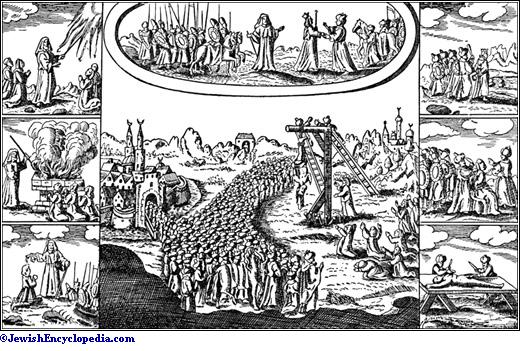GHAZZATI, NATHAN BENJAMIN BEN ELISHA HA-LEVI (called also Nathan Benjamin Ashkenazi):
Shabbethaian prophet; born at Jerusalem 1644; died at Sofia 1680. After studying Talmud and Cabala in his native town under Jacob Ḥagis, he settled at Gaza, whence his name "Ghazzati." The fact of his father being a German Jew gave him the name of "Ashkenazi." When Shabbethai Ẓebi reached Gaza on his way back from Cairo, Ghazzati entered into close relationship with him and became an ardent supporterof his claim and mission, advocating his cause with a vigorous pen. Shabbethai Ẓebi's disciples declared that Ghazzati had dug up a part of the ancient writing which testified that their master was the Messiah. Ghazzati then professed to be the risen Elijah, who was to clear the way for the Messiah. Prophetic revelations followed. In the spring of 1665 he announced that about the middle of the next year the Messiah would appear in glory, would take the sultan captive, and would establish the sway of Israel over all the nations of the earth. The dominion of Turkey would be entrusted to himself, while Shabbethai Ẓebi would conquer the other nations.
Seeing that the rabbis of Jerusalem were very hostile to the Shabbethaian movement, Ghazzati proclaimed Gaza to be henceforth the holy city. He first spread about the Messiah's fame by sending circulars from Palestine to the most important communities in Europe. Then he visited several of the chief cities in Europe, Africa, and India, and finally returned to Palestine. Even after Shabbethai Ẓebi's apostasy Ghazzati did not desert his cause; but, thinking it unsafe to remain in Palestine any longer, he made preparations to go to Smyrna. The rabbis, seeing that the credulous were confirmed anew in their belief, excommunicated all the Shabbethaians, and particularly Ghazzati (Dec 9, 1666), warning everybody against harboring or even approaching him. After a stay of a few months at Smyrna he went (end of April, 1667) to Adrianople, where, in spite of his written promise that he would remain quiet, he continued his agitation. He urged the Shabbethaians of Adrianople to proclaim their adhesion to the cause by abolishing the fasts of the 17th of Tammuz and the 9th of Ab.
Travels Through Europe.Again excommunicated at Adrianople, he went with a few followers to Salonica. There he met with scant welcome, but had more success in the communities of Chios and Corfu. From Corfu he went to Venice (March, 1668), where the rabbinate and the council of the city compelled him to give them a written confession that all his prophecies were the production of his imagination. The confession was published, whereupon Abraham ha-Yakini, the originator of the Shabbethaian movement, wrote Ghazzati a letter in which he condoled with him over his persecution and expressed his indignation at the acts of the Venetian rabbinate. The Venetian Jews then induced Ghazzati to set out for Leghorn, where the Jewish population was known to be inimical to him. They sent an escort with him, ostensibly as a mark of honor, but in reality to prevent him from going elsewhere. He divined their motives in sending him to Leghorn, however, and, succeeding in eluding his escort, proceeded to Rome. In spite of his disguise he was recognized there, and was banished from the city. He then went to Leghorn voluntarily, and even there made converts to his cause. From Leghorn he returned to Adrianople, and seems to have spent the remainder of his days in travel.

Ghazzati is supposed to have been the author of the anonymous "Ḥemdat Yamim," on morals, ritual customs, and prayers for week-days and holidays, a workin three parts, the second of which is followed by a pamphlet entitled "Hadrat Ḳodesh," cabalistic notes on Genesis (Constantinople, 1735). His "Oẓar Neḥmad" consists of extracts of and additions to the preceding work (Venice, 1738). He also wrote "Peri 'Eẓ Hadar," prayers for the 15th of Shebaṭ (ib. 1753), and "Tiḳḳun Ḳeri'ah," an ascetic work according to Shabbethaian doctrines (Amsterdam, 1666). His account of his travels was translated into German by M. Horschetzky and published in "Orient, Lit." ix. 170-172, 299-301.
- Grätz, Gesch. 3d ed., x. 197-202, 205, 215, 222-225:
- A. Epstein, in R. E. J. xxvi. 209-219;
- Jacob Emden, Torat ha-Ḳenaot, passim.


